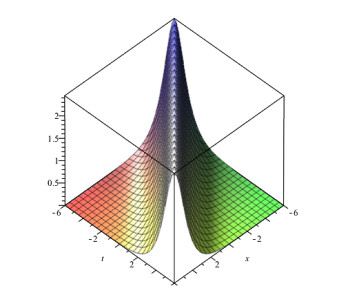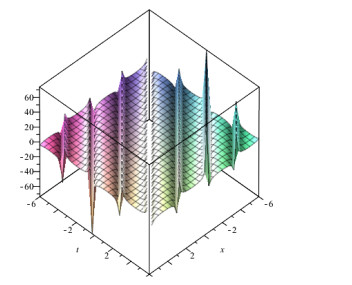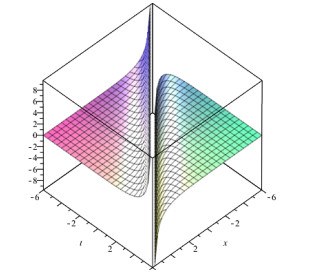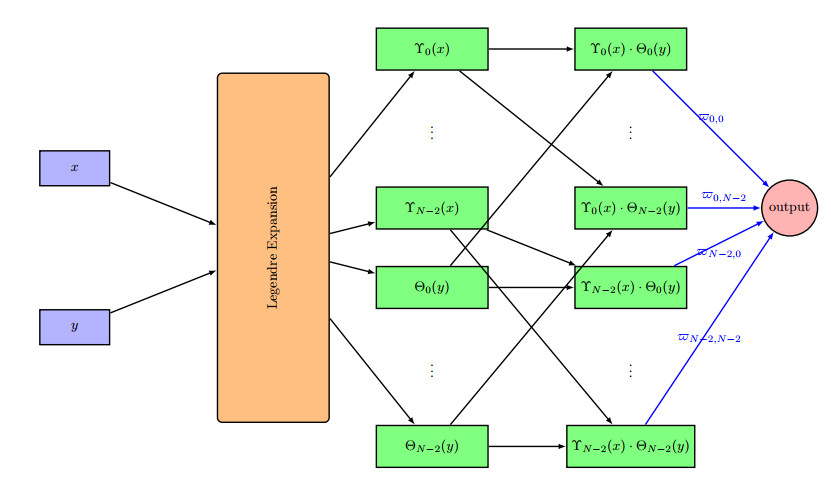1.
Introduction
Symmetry is a wonderful tool in explicating the laws of nature. One of the great stories of Lie's success was the initiation of a program to solve or at least to simplify the differential equation by using the Lie group theory on the analogy of ˊEvariste Galois's work to solve the algebraic equations having degrees two, three and four. But he was unable to give closed forms of roots of equations whose degrees are five or greater, by using only the arithmetic operation which are (+,−,÷,×,√) [1]. Lie's original ideas was to establish a general theory of integration of ordinary differential equation on the similar basis as Galois and Abel did for algebraic equations.
At first the method could not attract much attention until last few decades when a revival of the interests in Lie's theory was observed which resulted in a significate progress. The main hinderance was the complicated system of many differential equations which we obtain in symmetry analysis. Today we have strong computer algebra systems like Maple and Mathematica to handle this problem. Physical laws of nature are best governed by the exploitation of symmetries involved in the system. Real world phenomenons can be transformed into mathematical language by using non-linear PDE's. The non-linear PDE's have attracted much attention and have wide range of applications in science and engineering like plasma waves, fluid mechanics, optics, biological systems, chemical physics and financial systems. One such immensely popular class of equation is Non-linear Evolution Equation (NLEE's). Complex systems can be characterized by NLDE's. One particularly famous NLDE is the KdV equation derived by korteweg and de Vries [2]. It can be give in the following form,
It can be observed that this equation is a non-linear PDE in one dimension and describes the time-dependent motion of shallow water waves. Other equation is the Regularised Long wave equation (RLW) [3]. It is more common than KdV equation to depict the behaviour of non-linear dispersive waves. This equation can be written as,
Morrison et al. [4] introduced one dimensional non-linear Evolution Equation, in the given form,
It is also known as Equal Width wave (EW) equation [5,6,7,8,9,10] derived by using both KdV and RLW equation. Authors in [5] discussed solitary waves related to EW equation. Different methods have been adopted to find the solution of EW equations both numerically and analytically, see for instance [5,6,7,8,9,10]. Because of soliton solution with permanent speed and form, the wave has equal width for all wave amplitude. That's why it is called Equal Width wave equation. Here μ is a positive parameter, x, t denote space and time coordinate respectively, and u(x,t) represents wave amplitude with boundary condition u→0 as x→±∞. In plasma physics u represents −ve of electrostatic potential and in fluid problems, u represents wave vertical displacement of water surface [11]. Solitary wave solutions can also be found in EW equation. Soliton is unique type of solitary waves that retain it's shape after colliding with other objects.
The Modified Equal Width wave (MEW) equation is derived from EW equation and it has cubic non-linearity with dispersive wave form
This equation has also been discussed on large scale recently [12,13,14,15,16,17,18]. Authors solved this equation numerically in [12,18]. Some B-spline methods have been adopted to solve this equation in [13,14,15,16,17]. A generalization of EW equation also known as Generalized Equal Width wave (GEW) equation [19,20,21,22,23] can be derived from EW equation in following form
with n+1 non linearity and dispersion wave having solitary solution, where n ϵ Z+. This equation can be related with Generalized KdV equation [24] and Generalized RLW equation [25,26]. Solitary waves of GEW has been discussed in [19]. Raslan used collocation method to solve GEW in [20]. Some other methods also have been employed on this equation, see [21,22,23].
With the passage of time, application of DEs and it uses are increasing continuously. Many numerical as well as analytical method keep on emerging to solve PDE's. Some famous numerical method are Finite difference method [27], Multigrid method [28], Methods of lines [29], Domain decomposition method [30], Gradient discretization method [31], Mesh free method [32], Spectral method [33] and Quadratic B-spline method [34] etc. Some popular analytical methods are Daraboux transformation method [35,36], Inverse scattering method [37,38], Kudryashov method [39,40], Simplest equation method [41], Homogenous balance method [42], Tanh-coth method [43], Hirota bilinear method [44], Jacobi elliptic function expansion method [45,46], Sine-cosine method [47] and Lie symmetric method [48,49,50,51,52,53]. These methods give exact solutions of the PDE's. Many numerical and analytical method have been used to find the solution of EW equation, MEW equation and GEW equation. Zaki used the least square finite element method to find the numerical solution of EW equation [54]. Elein Yusufoglu et al. used He's variational iteration method to find the numerical solution of EW equation [55]. G. A Gardner et al. used Galerkin method to obtain numerical solution of EW equation [56]. B. G. Karakoc et al. used cubic B-spline lumped Galerkin method to find the numerical solution of MEW equation [57]. Khalique et al. used Jacobi elliptic expansion method to find the travelling wave solution of EW equation [58]. Evan et al. computed the solitary wave solution of GEW equation by using quadratic B-spline method [59]. S. Hamdi et al. discussed the exact solution of GEW equation [60]. Halil Zeybek obtained the numerical solution of GEW equation by using cubic B-spline Galerkin method [61]. S. B. G. Karakoc et al. used the septic B-spline collocation method to find the solution of GEW equation in [62] and derived numerical solution of GEW equation by using sextic B-spline finite element method in [63]. B. G. Karakoc et al. used the finite element method to find the numerical solution of GEW equation [64].
In this article, we find Lie symmetries and travelling wave solution of GEW equation by using Sine-cosine method. Lie symmetry approach has not been used for GEW equation. We use this method to reduce the complexity of GEW equation. It is worth mentioning that Lie symmetry method is the most important approach for constructing analytical solutions of nonlinear PDEs. We prefer to use Lie symmetry analysis because it studies the invariance of differential equations (DEs) under a one-parameter group of transformations which transforms a solution to another new solution and is used to reduce the order such as the number of variables of DEs; moreover, the conservation laws can be constructed by using the symmetries of the DEs. Kumar et al. effectively used this method for (3+1)-dimensional generalized KP equation in [48], (3+1)-dimensional KdV-type equation in [49], (2+1)-dimensional BK equation with variable coefficient in [50] and CHKP equation in [51]. Liu et al. used this approach to find the invariant solutions of SP equation in [52]. Chauhan et al. used this method to find traveliing wave solutions of EW equation in [53].
2.
General method to find the Lie symmetry
We describe a method to find the symmetry of non-linear PDEs in this section. For this, we consider the system of n−th order non-linear PDEs having p independent variable X=(x1,x2,.....,xp) ∈ Rp and q dependent variable U=(u1,u2,.....,uq) ∈ Rq has form
where U(n) = ∂un∂xn.
To construct the Lie symmetry, firstly we introduce a Lie group of transformation acting on both dependent and independent variable such as
where ε taken as a very small parameter, usually taken as ϵ<<<1 and ξc and ηd are infinitesimal generators with respect to the independent and dependent variable respectively.
The vector field of above transformation is
Thus the n−th prolongation of vector field v is also the vector field, which is
defined on the space M(n) ⊂ X×U(n), where S=(s1,s2,....sk), with 1 ≤ sk ≤ p, 1 ≤ k ≤ n, here
where urc = ∂ur∂xc, and urs,c = ∂urs∂xc, where the total derivative Dx and Dy is defined as
with condition
3.
Lie symmetry of Generalized Equal Width wave equation
Taking one parameter local Lie group of transformation having variable x, t and u are as follows:
where ε∈R is the group parameter. The vector field v of equation is defined as
The third order prolongation is defined as:
Now by applying the third order prolongation to the Eq (1.5), we get invariance condition
by putting the value of coefficients [φt], [φx] and [φxxt] in above equation
where Dt and Dx are total derivative. By applying the third order prolongation and use the value of φt, φx and φxxt, we get
By putting the value of ut and put the coefficients of various monomial equal to zero, we get the system of equations in term of partial derivatives, which is
We can solve this system manually or by using software Mathematica or Maple, so by solving the system we get infinitesimal
where C1, C2 and C3 are arbitrary constants. As a result, three vector fields spanned the Lie algebra of infinitesimal generators of Eq (1.5).
Thus the one-parameter Lie group Gi, (i=1,2,3) generated by the three vector fields H1, H2 and H3 which are
where ϵ∈R is the group parameter.
Since each group Gi is a symmetric group, so if u=h(t,x) is a solution of (1.5), so are the functions
3.1. Optimal system of one-dimensional subalgebras
An optimal system of one parameter Lie group is the collection of all inequivalent one parameter Lie group that any other subgroup is conjugate to one of group in the collection. To compute the optimal system, first we compute the commutator table.
The commutator table of Hi, (i=1,2,3) is
Now we proceed to compute the adjoint table.
The adjoint table for Hi, (i=1,2,3) is
Consider a generator of the form
where a1, a2 and a3 are arbitrary constant. We solve it by using different cases.
Case 1:
Let a1≠0 and a1=1, then
By acting Adjea2H2 on H, the coefficient a2 disappear.
Subcase 1: If a3<0, then
Subcase 2: If a3>0, then
Case 2:
Let a1=0 and a2=1, then
Subcase 1: If a3<0, then
Subcase 2: If a3>0, then
Case 3:
Let a1=0, a2=0 and a3=1, then
Case 4:
Let a3=0, then
By acting Adjea2a1H2 on H, we get
Case 5:
Let a1=a3=0 and a2≠0, then
So by using the optimal system method, we get the optimal system of Eq (1.5), which is ∙H1
∙H2
∙H3
∙H1±H3
∙H2±H3.
3.2. Lie symmetry reduction of Generalized Equal Width wave equation
In this section, we use the Lie symmetry method to find the exact solution of GEW equation. First by using the Lie symmetry, we convert PDEs into ODEs, then by using any appropriate method, we get the exact solution of ODEs. To obtain reduction form, we use subalgebra H1, H2, H3, H1+H3 and H2+H3.
Case 1:
The characteristic equation for H1=−1nu∂∂u+t∂∂t is
From this, we have
where r and s are constant of integration. So
So by putting the value of ut, ux and uxxt in Eq (1.5), we get
which is a 2nd order non-linear ODE, which we can solved numerically.
Case 2:
The characteristics equation for H2=∂∂t is
From this, we have
where r and s are constant of integration. So
So by putting the value of ut, ux and uxxt in Eq (1.5), we get
where c1 is the constant of integration.
Case 3:
The characteristics equation for H3=∂∂x is
So, we have
where r and s are constant of integration. Thus we have
By putting the value of ux, ut and uxxt in Eq (1.5), we have
which implies that
where c2 is the constant of integration.
Case 4:
The characteristics equation for H1+H3=∂∂x+t∂∂t−1nu∂∂u is
So we have
where r and s are constant of integration. Thus we have
By putting the value of ux, ut and uxxt in Eq (1.5), we get
which is a 3rd order non-linear ODE, which we can solve numerically.
Case 5:
The characteristic equation for H2+H3=∂∂t+∂∂x is
So, we have
where r and s are constant of integration. Thus we have
By putting the value ut, ux and uxxt in Eq (1.5), we get a 3rd order non-linear ODE.
4.
Travelling wave solution of Generalized Equal Width wave equation by using Sine-cosine method
Travelling wave: A wave in which medium move in the direction of propagation of wave is called travelling wave. We can find the travelling wave solution of those equation which propagation the wave property. The wave occur in the form of u(x,t) = f(x−ct), where c is the wave speed which move in negative direction as c < 0 and in positive direction as c > 0.
Procedure:
We consider the non-linear PDE's in the form
where u(x,t) is the travelling wave solution of non-linear PDE's. The wave variable ξ=x−ct is used to obtain the travelling wave solution so that u(x,t)=u(ξ), where ξ=x−ct.
This allow us to make the following modification:
The above equation was used to transfer PDEs to ODEs.
where u′=dudξ.
Equation (4.3) is then integrated till all terms contain derivative. For the sake of simplicity, the integration constant has been set to zero.
The solution of Sine-cosine method is in the forms
and
where λ and β are parameters and μ is the wave number and c is the wave speed. From Eqs (4.4) and (4.5), we have
and
By substitute Eqs (4.6) and (4.7) into (4.3), we get equation in the form of sinR(ξμ) or cosR(ξμ). Then to compute the parameter, we compare the exponent of each pair and then coefficient of equal power of cosk(ξμ) or sink(ξμ). Then we get the system of equation in μ, β and λ that will be determined.
The Sine-cosine method reduce the size of computational work than any other method which we have mention before.
4.1. Implementation of Sine-cosine method on Generalized Equal Width wave equation
The GEW equation is
here b is a parameter.
By using u(x,t)=u(ξ), ξ=x−ct. Equation (4.8) is transferred to non-linear ODE
Integrating (4.9) one time and use the constant of integration to be zero for the sake of simplicity, we find that
By using u(x,t)=λcosβ(ξμ) into (4.10), we get
By comparing the exponent of each pair and coefficient of equal power of cosk(ξμ), we get system of algebraic equation in β, μ and ξ, which is
By figuring out the system, we get
by putting the value of β, μ and λ in (4.4), we get the following periodic solution for b<0 as shown in Figure 1.
When we take b>0, we get the following soliton solution as shown in Figure 2.
If we put ansatz u(x,t)=λsinβ(μξ), then for b<0, we get periodic solution as shown in Figure 3.
And for b>0, we have soliton solution as shown in Figure 4.
5.
Graphical representation of some solutions
In this section we present the graphs of solution of the GEW equation. In Figure 1, we obtain periodic solution of GEW which is given in (4.14). It has wave speed value c=1.
In the Figure 2, we give a soliton solution of GEW equation for given values of parameters c=1, b=1, n=2 and x=−6..6, t=−6..6.
In the Figure 3, we give a periodic solution of GEW for given values of parameters c=1, b=−1, n=2 and x=−6..6, t=−6..6.
In the Figure 4, we give a soliton solution of GEW equation for given values of parameters c=1, b=1, n=2 and x=−6..6, t=−6..6.
6.
Conclusions
In the present article, we discussed the solution of Generalized Equal Width wave equation. We analysed the solution of GEW using two methods. At the first step transformed this PDE into ODE using Lie symmetry analysis. We used Lie symmetry analysis to reduce the complexity of the equations actually. It is worth-mentioning that GEW equation has not been discussed from the point of view of Lie symmetries. In the second step, we also used method of Sine-cosine to evaluate the exact solutions of this equation. We also analyzed the graphs of the solutions and found how they behave depending upon the parameters involved.
Acknowledgment
The fourth author thanks Prince Sultan University for funding this paper through the TAS research group.
Conflict of interest
The authors declare no conflict of interest.









 DownLoad:
DownLoad:
















